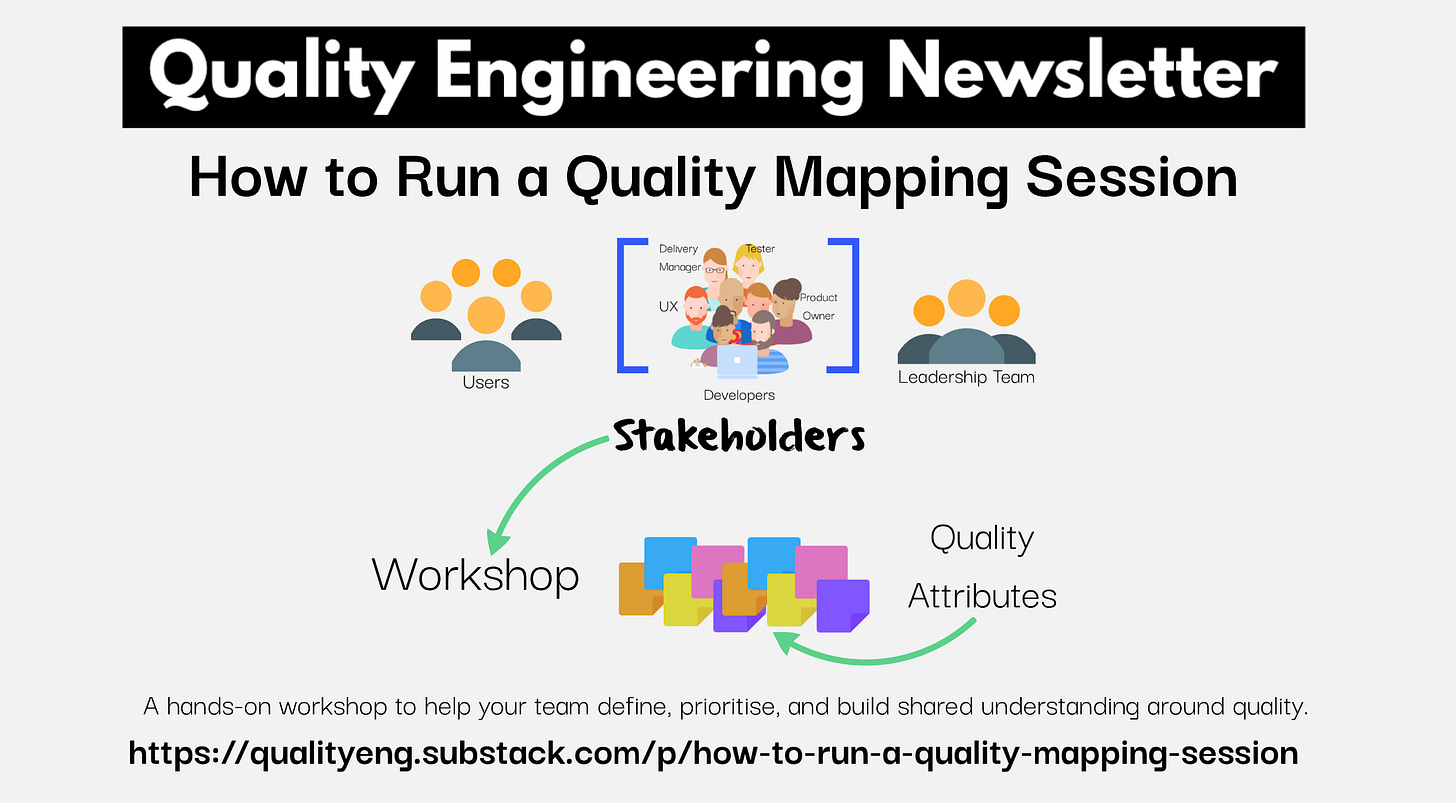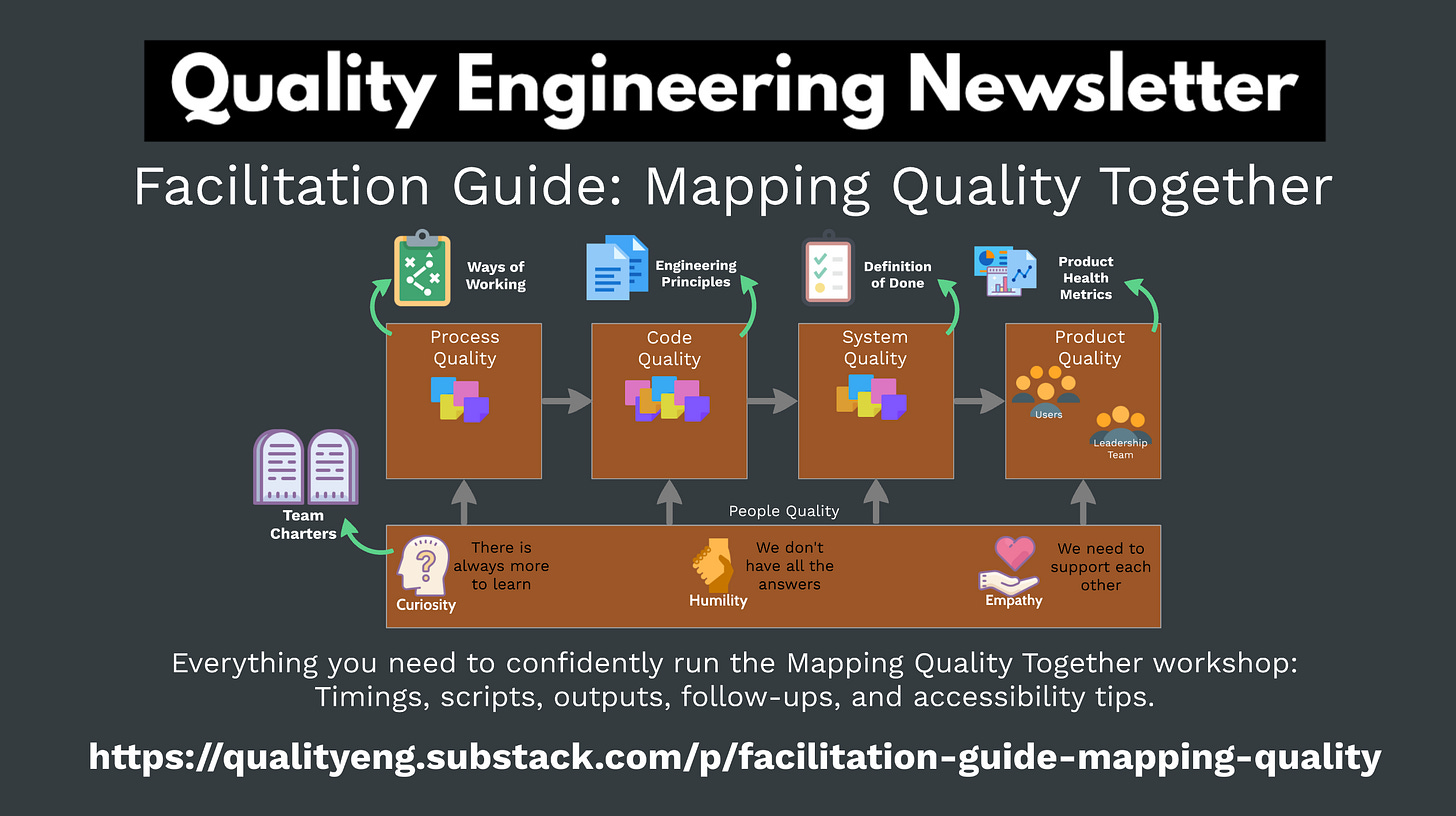
How to Run a Quality Mapping Session
I’m starting to share more hands-on resources. This one builds on Building Quality In - A Framework for Engineering Teams, and gives you everything you need to run a collaborative quality workshop with your team.
In that post, I suggested running a session with your stakeholders to surface the quality attributes they value most. This follow-up gives you a complete, ready-to-use format to do precisely that, including:
A 90–120 minute quality mapping session plan
High-level breakdown of each activity
Suggested timings and flow
If you’d like to see more practical workshops like this, let me know in the comments or just reply to this email. I’d love to hear what would be useful for you.
This version is free for everyone. If you’d like to go deeper with full facilitation guidance, prompts, and accessibility tips, check out the Facilitation Guide (available to paid subscribers).
Workshop: Mapping Quality Together
Goal: To collaboratively identify and categorise quality attributes that matter most for your product, with a special focus on the often-overlooked but critical role of people quality.
Duration: 90-120 minutes
Who should attend: Engineers, Testers, Designers, Product Managers, Delivery Managers, Tech Leads, Support Engineers, and any other key stakeholders
🛠️ Workshop Structure
1. Welcome & Framing (10 mins)
Facilitator introduces:
The purpose of the session: “To build a shared understanding of what quality means for our product from all our perspectives.”
Give a quick overview of the five quality buckets:
People Quality
Process Quality
Code Quality
System Quality
Product Quality
Share an example or two for each to clarify.
🛠️ Tip: Use a simple Miro/Mural board or whiteboard with five labelled spaces for these buckets.
2. Quality Attribute Brainstorm (25 mins)
Prompt: “What does good quality look like in our context? What do we value when we say something is high quality?”
🪞 Individual Reflection (5 mins):
Each person writes down as many quality attributes as they can (aim for 5-10 each). Encourage a mix: technical, procedural, experiential, interpersonal.
🗣️ Group Sharing (20 mins):
In small groups (3-4 people), participants share their attributes and cluster similar ideas. Each group then posts its set of attributes on the shared board (Miro, Mural, or Wall).
Quality Engineering Newsletter is a reader-supported publication. To receive new posts and support my work, consider becoming a free or paid subscriber.
3. Categorisation into the 5 Buckets (30 mins)
Now, working in mixed stakeholder groups, the teams collaboratively categorise the attributes into the five quality buckets.
👥 Breakout Teams (15 mins):
Each group takes a subset of the attributes and decides where each fits. They can place sticky notes or cards under the bucket headings.
🗣️ Whole Group Discussion (15 mins):
Review the placement together.
Allow reclassification if there are disagreements or overlaps.
Discuss any attributes that don’t fit neatly, especially where People Quality is foundational to others.
📝 Note: Highlight how many People Quality attributes emerge, and how they underpin the rest.
4. Gallery Walk & Voting (15 mins)
🖼️ Participants walk around (physically or virtually) and vote on the attributes they feel are most important right now. Use dot voting or digital voting.
🗳️ Give everyone 5 votes to distribute across any categories.
5. Group Reflection & Discussion (20 mins)
📢 Use these questions to guide an open conversation:
What surprised you?
What feels most important for our product and team?
Where are we strong? Where do we need to improve?
How do people quality attributes affect our ability to uphold the others?
6. Next Steps & Wrap-Up (10 mins)
Close the session with:
Summary of top-voted attributes
A plan to integrate them into your team documentation such as team charters, ways of working, engineering principles, definitions of done and product health metrics.
See How to apply the framework for more details.
Offer to follow up with a visual map or mural of the shared quality view
🧭 Optional Add-ons
Share Google’s software quality framework and the Wikipedia 90 attributes as pre-reading or reference material during the session.
Include a People Quality Primer e.g. short stories or prompts like: “Think about a time when collaboration worked really well, what behaviours made that happen?”
🔐 Want the full facilitation guide?
If you’re looking for more detailed support, including scripts, outputs, accessibility tips, and a pre-session checklist, I’ve put together a complete facilitation guide just for paid subscribers.
👉 Get the full Facilitation Guide here
I’d love to hear what you think
Would you find more workshop resources and facilitation guides useful? Let me know by replying to this email or leaving a comment.
Also what’s your take on the emojis? I think they help with skimming and navigation, but I know they’re not for everyone.
Your feedback helps me shape future posts, so I’m looking forward to hearing from you.


